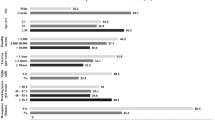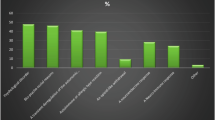Abstract
The objective of this study was to determine the prevalence of sexual dysfunction in Saudi and non-Saudi female health care providers in Jeddah, Saudi Arabia. One -hundred twenty (60 Saudi and 60 non-Saudi) sexually active female health care professionals in Jeddah, Saudi Arabia, were anonymously surveyed using the English version of the female sexual function index questionnaire. The individual domain scores for pain, arousal, lubrication, orgasm, satisfaction, pain and overall score for the Saudi and non-Saudi women were calculated and compared. The two groups were comparable in demographic characteristics. No statistically significant differences were found between Saudi and non-Saudi women in desire (P = .22) and arousal scores (P = .47). However, non-Saudi women had significantly higher lubrication (P < .001), orgasm (P = .015), satisfaction (P = .004) and pain scores (P = .015). The overall scores in Saudi and non-Saudi women were low (23.40 ± 4.50 compared with 26.18 ± 5.97), but non-Saudi women had a significantly higher overall score (P = .005). Taken together, sexual dysfunction is prevalent among Saudi and non-Saudi female health care providers, with Saudi women demonstrating lower scores in four sexual function domains and the overall score.
Similar content being viewed by others
Introduction
Female sexual dysfunction (FSD) is a highly prevalent and often underestimated problem in the general community1. It is defined as a disorder of sexual desire, orgasm, arousal and sexual pain that results in significant personal distress. It is a multifactorial, age-related, progressive problem2. The Female Sexual Function Index (FSFI), which was developed by Rosen et al. in 2000, is a 19-item, self-report measure of sexual dysfunction in women3. The FSFI was developed as a brief, multidimensional questionnaire with subscales to assess the major components of sexual function in women, including sexual desire, arousal, orgasm, pain and satisfaction. It has been shown in several validation studies that the FSFI is highly reliable and valid4,5,6. Thus far, the FSFI has been translated into more than 20 languages and it has become the de facto ″gold standard″ in the assessment of female sexual function and an indispensable tool in clinical research of FSD7. Few reports in Saudi Arabia have described FSD due to the relatively sensitive nature of the theme and the religiosity of the population8,9. The aim of this study was to assess the FSD using the English version of the FSFI in female health care providers in Jeddah, Saudi Arabia.
Results
During the study period, a total of 120 female health care professionals were enrolled in the study. Of these participants, 60 were Saudi and 60 non-Saudi. Ten (7.7%) women (7 Saudi and 3 non-Saudi) declined to participate. The two groups were comparable in demographic characteristics. The age (mean ± SD) of the respondents was 35.0 ± 6.13 years and 36.9 ± 6.89 years for Saudis and non-Saudis, respectively (Cohen's d 0.29; P = .152). Similarly, the parity was 2.7 ± 1.57 and 2.1 ± 1.16 for Saudi and non-Saudi women (Cohen's d, 0.41; P = .26); Saudi and non-Saudi women had been married for 10.3 ± 6.31 and 9.4 ± 5.81 years, respectively (Cohen's d, 0.15; P = .42). There were no statistically significant differences between the Saudi and non-Saudi groups in the mean desire score (Cohen's d, 0.22; P = .22) and arousal score (Cohen's d, 0.13; P = .47; Table 1). However, non-Saudi women had significantly higher lubrication (Cohen's d, 0.71; P < .001), orgasm (Cohen's d, 0.44; P = .015), satisfaction (Cohen's d, 0.53; P = .004) and pain scores (Cohen's d; 0.44; P = .015). The overall scores of Saudi and non-Saudi women were low (23.40 ± 4.50 compared with 26.18 ± 5.97), but non-Saudi women had a significantly higher score (Cohen's d, 0.52; P = .005).
Discussion
Impaired sexual function can have damaging effects on the self-esteem, sense of wholeness and interpersonal relationships of women. It is often emotionally distressing10. Cultural beliefs as well as inconsistencies in the levels of normal sexual function and the relevance of sexual function in individuals complicates the classification and determination of FSD. The use of the FSFI is currently considered the gold standard11. It has been validated in many samples of women with mixed sexual dysfunctions and it has been demonstrated to possess excellent psychometric properties. More recent validation studies have correctly identified 77% of women with sexual dysfunction and 85% of women with normal sexual function12,13. In the literature, risk factors for FSD include age, history of sexual abuse or sexually transmitted infection, depression, lower educational attainment, overall state of general happiness, physical health, life-style and sexual experience6,7. Female sexual dysfunction is a prevalent health problem that has been inadequately investigated in the Arab world. However, there are few published reports on FSD from Saudi Arabia. Two studies used a non-validated Arabic version of FSFI in pregnancy and in women with female genital mutilation9,14. Another study used the Arizona Sexual experience Scale in women with unstable angina or non-ST-elevation myocardial infarction8. This study aimed to assess sexual function in health care professionals in Jeddah, Saudi Arabia. The main strengths of this study are its prospective nature, high participation rate (92.3%), adequate sample size and use of the English version of FSFI (not the non-validated Arabic version). The lack of previous local studies has made it difficult to make relevant comparisons between our findings and those of other authors. Overall, our findings demonstrate that FSD is displayed in our population of young and employed female health care providers in Saudi Arabia. Moreover, Saudi women showed significantly lower FSFI scores as well as lower scores in four sexual function domains.
Methods
This cross-sectional study was performed during scientific meetings at Erfan and Bagedo Hospital, Jeddah, Saudi Arabia. Ethical approval was granted by the Ethics Research Committee of Erfan and Bagedo Hospital. This study was performed in accordance with relevant guidelines and regulations. The target sample included female health care professionals (physicians and nurses) who lived in Jeddah. Informed consent was obtained from all of the participants prior to recruitment and they were assured of the confidentiality of the data by a number (subject identifier), which was inscribed on the questionnaire. The English version of the FSFI questionnaire and a cover letter explaining the objective of the study were distributed to female health care providers. Participants were asked to complete the anonymous questionnaire privately and return it. The self-assessment instrument included 19 items that tapped the women's reports of their sexual experience over the last four weeks; the 19 questions covered six domains: desire (two questions), arousal (four questions), lubrication (four questions), orgasm, satisfaction and pain (three questions each)3. Responses to questions 1, 2, 15 and 16 were scored from 1 to 5; all of the other questions were scored from 0 to 5. Individual domain scores were determined by the sum of the scores of the individual questions in the domain and the sum was multiplied by the domain factor in the FSFI. The overall scale score was calculated by the sum of the six domain scores, which from 2 to 3611. Women with FSFI scores < 26.55 were categorized as experiencing sexual dysfunction, while respondents with scores above this cutoff value were categorized as experiencing normal sexual function11. To determine the difficulties experienced on each of the six domains of the FSFI, the cutoff scores were obtained from previous reports4,10,11. Thus, participants were considered to have difficulties in a particular domain if they demonstrated scores < 4.28 on the desire domain, <5.08 on the arousal domain, <5.45 on the lubrication domain; <5.05 on the orgasm domain, <5.04 on the satisfaction domain and <5.51 on the pain domain. The data were analyzed using the Statistical Package for the Social Sciences (SPSS Inc., Chicago, IL, USA), version 22.0. Descriptive statistics were computed for all of the variables. The chi-square test was used to compare the categorical variables, while the independent t-test was used to compare the mean scores between Saudi and non-Saudi women. Cronbach's alpha was used to assess the internal reliability of the items within each scale. The results are expressed as the mean ± standard deviation (SD). Differences were considered significant at the 5% level (p < 0.05).
References
Raina, R. et al. Female sexual dysfunction: classification, pathophysiology and management. Fertil Steril. 88, 1273–84 (2007).
Basson, R. et al. Report of the international consensus development conference on female sexual dysfunction: definitions and classifications. J Urol. 163, 888–93 (2000).
Rosen, R. et al. The Female Sexual Function Index (FSFI): A multidimensional self-report instrument for the assessment of female sexual function. J Sex Marital Ther. 26, 191–208 (2000).
Meston, C. M. Validation of the Female Sexual Function Index (FSFI) in women with female orgasmic disorder and in women with hypoactive sexual desire disorder. J Sex Marital Ther. 29, 39–46 (2003).
Sidi, H., Abdullah, N., Puteh, S. E. & Midin, M. The Female Sexual Function Index (FSFI): Validation of the Malay version. J Sex Med. 4, 1642–54 (2007).
Chang, S. R., Chang, T. C., Chen, K. H. & Lin, H. H. Developing and validating a Taiwan version of the female sexual function index for pregnant women. J Sex Med. 6, 1609–16 (2009).
Sun, X., Li, C., Jin, L., Fan, Y. & Wang, D. Development and validation of Chinese version of Female Sexual Function Index in a Chinese population-A pilot study. J Sex Med. 8, 1101–11 (2011).
Eyada, M. & Atwa, M. Sexual function in female patients with unstable angina or non-ST-elevation myocardial infarction. J Sex Med. 4, 1373–80 (2007).
Alsibiani, S. A. Effects of pregnancy on sexual function. Findings from a survey of Saudi women. Saudi Med J. 35, 482–7 (2014).
Oksuz, E. & Malhan, S. Prevalence and risk factors for female sexual dysfunction in Turkish women. J Urol. 175, 654–658 (2006).
Female sexual function index. Available at: http://www.fsfiquestionnaire.com.
Wiegel, M., Meston, C. & Rosen, R. The female sexual function index (FSFI): Cross-validation and development of clinical cutoff scores. J Sex Marital Ther. 31, 1–20 (2005).
Meston, C. M. & Derogatis, L. R. Validated instruments for assessing female sexual function. J Sex Marital Ther. 28, 155–64 (2002).
Alsibiani, S. & Rouzi, A. A. Sexual function in women with female genital mutilation. Fertil Steril. 93, 722–24 (2010).
Acknowledgements
The authors would like to thank Pavol Prokop from the Department of Biology, Faculty of Education, Trnava University, Trnava, Slovakia for his comments and suggestions to improve the quality of the manuscript.
Author information
Authors and Affiliations
Contributions
A.R.: Design of the study, analysis of the data and writing of the manuscript. N.S.: Performance of the study, collection and analysis of the data. D.S.: Performance of the study. S.K.: Performance of the study and collection of the data. F.A.: Performance of the study. All authors reviewed the manuscript.
Ethics declarations
Competing interests
The authors declare no competing financial interests.
Rights and permissions
This work is licensed under a Creative Commons Attribution-NonCommercial-NoDerivs 4.0 International License. The images or other third party material in this article are included in the article's Creative Commons license, unless indicated otherwise in the credit line; if the material is not included under the Creative Commons license, users will need to obtain permission from the license holder in order to reproduce the material. To view a copy of this license, visit http://creativecommons.org/licenses/by-nc-nd/4.0/
About this article
Cite this article
Rouzi, A., Sahly, N., Sawan, D. et al. The prevalence of sexual dysfunction in the female health care providers in Jeddah, Saudi Arabia. Sci Rep 5, 7905 (2015). https://doi.org/10.1038/srep07905
Received:
Accepted:
Published:
DOI: https://doi.org/10.1038/srep07905
This article is cited by
-
Abnormal Sexual Behavior During Sleep: Sexsomnia and More
Sleep and Vigilance (2019)
Comments
By submitting a comment you agree to abide by our Terms and Community Guidelines. If you find something abusive or that does not comply with our terms or guidelines please flag it as inappropriate.



